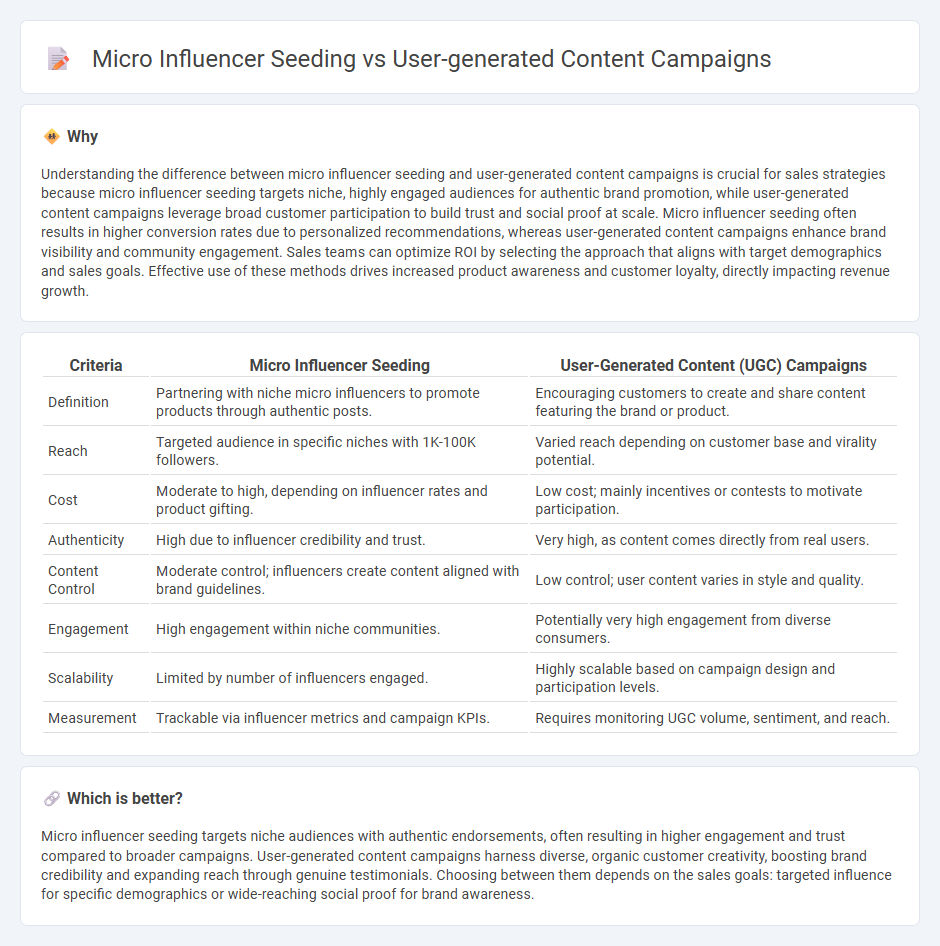
Micro influencer seeding campaigns leverage carefully selected individuals with niche, engaged audiences to create authentic brand endorsements, driving higher trust and targeted reach. User-generated content campaigns involve customers producing organic content that enhances brand credibility and fosters community engagement through diverse, relatable experiences. Discover how these strategies can amplify your sales by exploring detailed comparisons and best practices.
Why it is important
Understanding the difference between micro influencer seeding and user-generated content campaigns is crucial for sales strategies because micro influencer seeding targets niche, highly engaged audiences for authentic brand promotion, while user-generated content campaigns leverage broad customer participation to build trust and social proof at scale. Micro influencer seeding often results in higher conversion rates due to personalized recommendations, whereas user-generated content campaigns enhance brand visibility and community engagement. Sales teams can optimize ROI by selecting the approach that aligns with target demographics and sales goals. Effective use of these methods drives increased product awareness and customer loyalty, directly impacting revenue growth.
Comparison Table
| Criteria | Micro Influencer Seeding | User-Generated Content (UGC) Campaigns |
|---|---|---|
| Definition | Partnering with niche micro influencers to promote products through authentic posts. | Encouraging customers to create and share content featuring the brand or product. |
| Reach | Targeted audience in specific niches with 1K-100K followers. | Varied reach depending on customer base and virality potential. |
| Cost | Moderate to high, depending on influencer rates and product gifting. | Low cost; mainly incentives or contests to motivate participation. |
| Authenticity | High due to influencer credibility and trust. | Very high, as content comes directly from real users. |
| Content Control | Moderate control; influencers create content aligned with brand guidelines. | Low control; user content varies in style and quality. |
| Engagement | High engagement within niche communities. | Potentially very high engagement from diverse consumers. |
| Scalability | Limited by number of influencers engaged. | Highly scalable based on campaign design and participation levels. |
| Measurement | Trackable via influencer metrics and campaign KPIs. | Requires monitoring UGC volume, sentiment, and reach. |
Which is better?
Micro influencer seeding targets niche audiences with authentic endorsements, often resulting in higher engagement and trust compared to broader campaigns. User-generated content campaigns harness diverse, organic customer creativity, boosting brand credibility and expanding reach through genuine testimonials. Choosing between them depends on the sales goals: targeted influence for specific demographics or wide-reaching social proof for brand awareness.
Connection
Micro influencer seeding leverages targeted individuals with niche audiences to authentically promote products, driving user-generated content (UGC) as followers organically share experiences. This synergy amplifies brand visibility by generating diverse, relatable content that boosts social proof and engagement. Effective sales strategies harness these campaigns to increase conversion rates, as consumer trust grows through peer recommendations and authentic storytelling.
Key Terms
User-Generated Content Campaigns:
User-generated content (UGC) campaigns leverage authentic content created by customers to increase brand trust and engagement, often resulting in higher conversion rates compared to traditional advertising. These campaigns encourage participation through contests, hashtags, or challenges, amplifying organic reach and fostering a community around the brand. Discover how UGC campaigns can transform your marketing strategy and boost customer loyalty through genuine brand advocacy.
Authenticity
User-generated content campaigns leverage genuine customer experiences to enhance brand authenticity and foster trust, while micro influencer seeding involves partnering with niche influencers whose endorsements resonate with targeted audiences for credible engagement. Both approaches emphasize authentic storytelling but differ in execution; user-generated content is organic and community-driven, whereas micro influencer seeding strategically amplifies brand messages through carefully selected voices. Explore how combining these strategies can maximize authenticity and impact in your marketing efforts.
Engagement
User-generated content (UGC) campaigns drive authentic interactions by encouraging real customers to share personal experiences, significantly boosting engagement rates. Micro influencer seeding leverages niche influencers with dedicated followers to create targeted, relatable content, generating higher trust and interaction. Explore detailed strategies to maximize engagement using both UGC and micro influencer seeding.
Source and External Links
21 User-Generated Content Examples For Your Next Marketing ... - User-generated content (UGC) campaigns involve setting clear objectives, choosing the right platform, establishing guidelines, providing incentives, promoting the campaign, engaging with participants, moderating submissions, measuring success, showcasing the best content, and thanking participants to build authenticity and community connection.
UGC Content 101: A Comprehensive Introduction - UGC is content created by customers or fans rather than brands, and campaigns leveraging UGC benefit from authenticity, resulting in higher consumer trust and often increased conversions, involving contributions from customers, brand loyalists, social followers, and specialized UGC creators.
10 User Generated Content Campaigns That Actually Worked [+ ...] - Successful UGC campaigns use strong calls-to-action such as hashtags or tagging, encourage user participation by featuring submitted content publicly, and leverage the insights gained from UGC to inform product development and marketing strategies.
 dowidth.com
dowidth.com